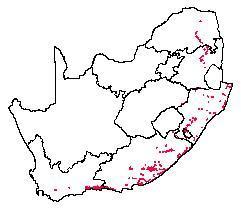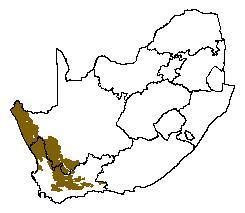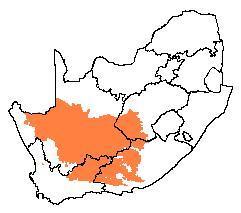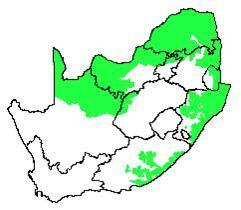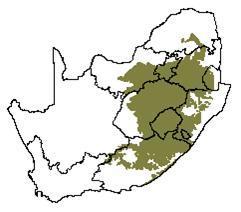Fynbos
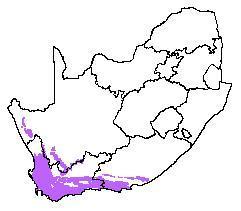
The various Fynbos vegetation types comprise most of the area of the Fynbos Biome. Fynbos is characterized by the presence of the following three elements:
-
A restioid component, belonging to the Restionaceae or the Cape Reed Family. Some definitions require a mere 5% cover of restiods in an area to classify it as a Fynbos vegetation type. The Restionaceae have been described as shrubby grasses, and replace grasses on nutrient-poor soils where there is a strong winter component to the annual rainfall. Sedges and many grasses within Fynbos also share the "restioid" characters of reduced or absent leaves and tough, wiry stems.
-
An ericoid or heath component. By far the majority of plant species - and the greatest cover after restioids comprise plants with small, narrow, rolled leaves with thick-walled cells on the upper leaf surface and a channel containing hairs on the lower surface. Although the Heaths (Ericaceae) feature prominently, the Daisy (Asteraceae), Blacktip (Bruniaceae), Pea (Fabaceae), Jujube (Rhamnaceae) and Thyme (Thymelaeaceae) Families also have structurally similar leaves. Many of these plants are wispy and insubstantial, although some form quite dense bushes.
-
A proteoid component. These plants, almost exclusively of the Proteaceae, have broad, isobilateral (both surfaces similar) leaves. They are the dominant overstorey in Fynbos. Although some members occur in ecotones and some occur in Renosterveld, by far the majority are confined to Fynbos.
Fynbos is characterized by the presence of seven endemic or near-endemic plant families: Blacktips (Bruniaceae), Guyalone (Geissolomaceae), Sillyberry (Grubbiaceae), Brickleaf (Penaeaceae), Buttbush (Retziaceae), Dewstick (Roridulaceae) and Candlestick (Stilbaceae). Only the Bruniaceae (75 spp.), Penaeaceae (21 spp.) and Stilbaceae (13 spp.) comprise more than five species. The fifteen largest families comprise 70% of the species in the Fynbos Biome (Table 3).
Over 9 000 plant species occur in the Fynbos vegetation types. Endemicity is very high - over 80% of plant species are confined to the Cape Floral Kingdom and Fynbos Biome. The majority of these, although exact numbers are unknown, are confined to one or more of the various Fynbos vegetation types.
Many species have very narrow distributional ranges. Thus, based on the Proteaceae for which we have the most finely detailed data, some 24 centres of endemism (areas with species sharing similar localized distributional ranges) have been identified.
The largest families and genera in the Cape Floral Kingdom. Included are all families with over 200 species (and their largest genus) and those families containing a genus with more than 100 species. (Source: Bond & Goldblatt 1984)
Family Total species Endemic species Largest genus Species
Daisy: Asteraceae 986 608 Senecio 113
Heath: Ericaceae 722 700 Erica 550
Vygie: Mesembryanthemaceae 660 507 Ruschia 138
Pea: Fabaceae 644 525 Aspalathus 245
Iris: Iridaceae 612 485 Gladiolus 88
Protea: Proteaceae 320 306 Leucadendron 80
Cape Reed: Restionaceae 310 329 Restio 85
Figwort: Scrophulariaceae 310 160 Selago 59
Buchu: Rutaceae 259 242 Agathosma 130
Bellflower: Campanulaceae 222 157 Lobelia 42
Orchid: Orchidaceae 206 124 Disa 52
Sedges: Cyperaceae 203 124 Ficinia 57
Milkwort: Polygalaceae 139 117 Muraltia 106
Jujube: Rhamnaceae 136 122 Phylica 133
Storkbill: Geraniaceae 133 67 Pelargonium 125
Sorrel: Oxalidaceae 129 90 Oxalis 129
Rose: Rosaceae 114 97 Cliffortia 106
Whereas there is near unanimity as to the definition of Fynbos as a unit, there are widely divergent opinions on the major vegetation types within Fynbos. This stems from the high species richness and the large number of localized species, which prevents an easy comparison of species lists between centres of endemism. Consequently, the definition of vegetation types based on species composition, the basis for determining types in the other biomes, has never been achieved in Fynbos.
A structural approach, suggested by Campbell in 1985, recognises Proteoid, Ericaceous, Restioid, Asteraceous, Shrubby and Grassy vegetation types. This approach denies a difference in Fynbos types between the mountains and the lowlands of the Biome. However, the different types occur on a scale too fine to map here Ericaceous on the wet, upper south slopes, Asteraceous on the drier northern slopes and the wetter, shale-derived soils, Restioid on the winter water-logged and summer and slopes, and Proteoid on the richer colluvial, sandstone-derived soils. Shrubby Fynbos is ecotonal to forest where rock outcrops, gorges and stream courses protect the vegetation from fires, and Grassy Fynbos predominates where the summer component of the rainfall allows grasses to outcompete the restioids. These basic components are further subdivided into over 60 types based on structural adaptations.
An older classification by Moll & Bossi in 1983, recognized three main types of Fynbos. These are Mountain, Grassy and Lowland Fynbos. The Grassy type corresponds to that of Campbell. However, the Mountain and Lowland dichotomy has never been defined or defended. It has been criticised as merely one of cartographic convenience. Mountain Fynbos was classified into Dry, Mesic and Wet Fynbos, with a fourth type - Arid (for the northern Cederberg and Swartberg) - perhaps required. Grassy Fynbos was categorized as either Mesic (on southern slopes and nearer the coast) or Dry (northern slopes and predominantly inland). Lowland Fynbos was subdivided into three main types based on their edaphic (soil) requirements. Of the three, only the subdivisions of the Lowland Fynbos types correspond to mapable patterns of endemism and are adopted here (the other units were recognized on LANDSAT satellite imagery, but do not correspond to structural vegetation type classes).
Fynbos vegetation types occur predominantly on well leached, infertile soils. The Cape Supergroup sandstones typically produce such soils, but under high rainfall conditions, granites and even shales become sufficiently leached to support Asteraceous Fynbos, replacing Renosterveld. This usually occurs at about 600 to 800 mm annual rainfall, but may be much less on granites, especially at higher altitudes. Below 200 mm Fynbos is replaced by Succulent Karoo, presumably because at such low rainfall, the vegetation does not burn frequently enough.
Fynbos has a low animal biomass, although species richness of birds, mammals, frogs, reptiles and insects is quite high, and most Fynbos Biome endemics occur in Fynbos vegetation types. Although these animals play a major role in pollination and seed dispersal, they appear to play a minor part in influencing vegetation structure and composition. This is partly due to the high carbon to nitrogen ratio, which effectively excludes browsing of all but the youngest leaves.
Fire is a major influence on Fynbos community processes. Fynbos must burn at between 6 and 45 years of age in order to sustain its plant species. Many species store their fruit in fire-safe cones for release after a fire, and ants are enticed to bury fruit where they are safe from rodents and fire. After fire many plant species resprout, but the majority rely on the predictability of fires and only regenerate after the fire from seeds. Without fire, Fynbos becomes senescent and Forest and Thicket elements begin invading.
Because of the low productivity of Fynbos vegetation types, due to the infertile soils, they are little utilized for agriculture. The major use of Fynbos is for recreation, water catchment and exotic plantations. In some areas vegetation harvesting for the cut-flower trade occurs, and wild flower orchards are being established in Fynbos areas. The implications of these for hybridization and gene transfer are poorly understood and are of conservation significance - we need to conserve the genetic material for future cultivar selections rather than lose wild genetic reserves by careless orchard placement. On richer soils where the rainfall is high, Fynbos has been converted to fruit orchards and vineyards. With more modern agricultural techniques (liquid fertilisation, terracing, hydroponics) much marginal land is becoming suitable for agriculture. At present dam building - both for agricultural and urban use - is a threat, albeit a minor one, compared with alien encroachment, urbanization and fires.
Source: Low, A.B. & Rebelo, A.(T.) G. 1998. Vegetation of South Africa, Lesotho and. Swaziland, edn 2. Dept of Environmental Affairs and Tourism, Pretoria.




